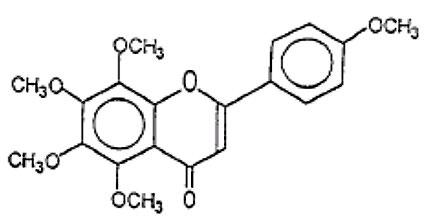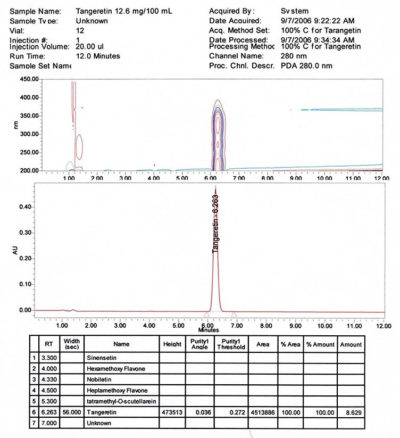A bioflavonoid found in citrus peel (Citrus sinensis) shows cholesterol lowering, anticancer and neuroprotective activity
- Catalog No: APH-06051
- CAS Number: 481-53-8
- Chemical Formula: C20H20O7
- Molecular Weight: 372.37
- Purity: > 99 % CP
- Appearance: White crystalline solid
- Solubility: Soluble in methanol or ethyl acetate; insoluble in water.
- Stability: Stable as a solid over extended period at -20°C.
- Storage: Store at room temperature
- Shipping: On ice (5ºC)
- Handling: Avoid exposure to oxygen and direct sunlight.
Source:
Tangeretin is a flavonoid found in the peel of citrus fruits, including mandarins, tangerines, grapefruits and oranges (Rouseff and Ting, 1979). The highest concentration of tangeretin is found in the flavedo, which contains on average 87.5% of the tangeretin concentration (Rouseff and Ting, 1979). Tangeretin has the usual flavonoid structure with five methoxyl groups, which increases its hydrophobic character.
At Aphios®, Tangeretin is extracted from Citrus sinensis using supercritical fluid, and then purified using silica and C18 chromatography.
Biological Activity:
Tangeretin shows a range of bioactivity that includes lowering cholesterol, anti-tumor activity and neuroprotective action. The safe oral administration of tangeretin in laboratory mice has further increased its potential applicability for human consumption (Vanhoecke et al., 2005).
Research on hamsters has shown that citrus polymethoxylated flavones, including tangeretin, show hypolipidemic activity, significantly lowering serum total and very low-density lipoprotein + LDL cholesterol (Kurowska et al., 2004). Additionally, a study performed on a lesion rat model of Parkinson’s disease showed that high doses of tangeretin reduce loss of tyrosine hydroxylase-positive cells and striatal dopamine content in cells exposed to a neurotoxin, thereby acting as a neuroprotective agent (Datla et al., 2001).
Additionally, Tangeretin shows potential as an anti-cancer agent (Hirano et al., 1995; Manthey and Guthrie, 2002). In in vitro studies, tangeretin has been shown to induce apoptosis in in leukemia cells (IC50 range from 0.062 and 0.173 µM) while showing no cytotoxicity against normal immune cells (Hirano et al., 1995). It appears to act by stopping cancer cells in phase G1 of the cell cycle, thus preventing replication (Hirano et al., 1995). Methoxylated flavones seem to show, in general, strong anti-proliferative activities against human cancer cell lines (Manthey and Guthrie, 2002).
References:
Datla K, Christidou M, Widmer W, Rooprai H and Dexter D. (2001). Tissue distribution and neuroprotective effects of citrus flavonoid tangeretin in a rat model of Parkinson’s disease. Neuroreport. 12: 3871-3875.
Hirano T, Abe K, Gotoh M and Oka K. (1995). Citrus flavone tangeretin inhibits leukaemic HL-60 cell growth partially through induction of apoptosis with less cytotoxicity on normal lymphocytes. Br J Cancer. 72(6): 1380-1388.
Kurowska E and Manthey J. (2004). Hypolipidemic effects and absorption of citrus polymethoxylated flavones in hamsters with diet-induced hypercholesterolemia. J Agric Food Chem. 52: 2879-2886.
Manthey J and Guthrie N. (2002). Antiproliferative activities of citrus flavonoids against six human cancer cell lines. J Agric Food Chem 50: 5837-5843.
Rouseff R and Ting S. (1979). Tangeretin content of Florida citrus peel as determined by HPLC. Proc Fla State Hort Soc. 92: 145- 148.
Vanhoecke B, Delporte F, Van Braeckel E, Heyerick A, Depypere H, Nuytinck M, De Keukeleire D and Bracke M. (2005). A safety study of oral tangeretin and xanthohumol administration to laboratory mice. In vivo 19: 103-108.

